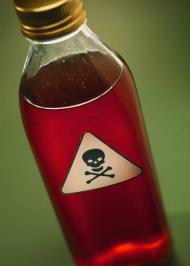Call 9-1-1 if a poisoning occurs
If a poisoning does occur, follow these guidelines:
-
Be prepared. Keep the phone numbers of the local poison control center, physician, and emergency medical service next to each telephone. Always keep a bottle of ipecac syrup on hand (one per child), but use it only on the advice of a poison control center, emergency medical service personnel, or physician.
-
Call for help. If you suspect a child has swallowed something, check his or her mouth. Remove any remaining poison from the child's mouth, then call your local poison control center, physician, or other emergency medical services. When calling, bring the container of the ingested substance to the phone with you. Call even if you are not sure that the child was poisoned. The poison center staff or emergency personnel will determine if you need to do anything for the child. Do not give the child anything to treat the poison until you have consulted a poison control center or a health care professional. Vomiting can often aggravate the poisoning and cause even greater long-term damage.
-
Rinse skin with water. If a poison has come in contact with your child's skin, rinse the skin with running water for 15 minutes. Don't touch the poison. Take off any contaminated clothing. Call the poison control center or emergency medical service immediately.
-
Flush eyes with water. If a poison has gotten into your child's eyes, gently hold his or her eyelids open and pour cool water into them for 15 minutes. Do not let the child rub his or her eyes, and do not put the child's head directly under a faucet to irrigate the eyes. Once again, call the poison control center or emergency medical service immediately.
We recommend parents and caregivers eliminate hidden household poisons. Storing household cleaners, medicines and vitamins locked away and out of reach is a smart and simple safety intervention that could save a child's life.
-
Keep poisonous products out of reach. Storing potentially harmful products out of sight and reach - in cabinets with safety locks - is one of the best ways to prevent poisonings. Know which household products are poisonous. Something as common as mouthwash can be poisonous due to its alcohol content if a child swallows a large amount.
-
Stay alert while using poisonous household products. Many poisonings occur while adults are using a household product like a bathroom cleaner or bleach. Adults should know where children are when these products are in use. Never leave a child alone in a room with a poisonous product. It takes only seconds for a poisoning to occur.
-
Never refer to medicine or vitamins as candy. Referring to medicine as candy could cause a child to think that it is harmless or pleasant to eat. Since children tend to mimic adults, avoid taking medications in front of them. Vitamins, particularly those containing iron, can also be poisonous to children. Keep them out of your child's reach at all times and carefully monitor their use.
-
Throw away old medicines and other potential poisons. Discard old medicines on a regular basis by flushing them down the toilet. Check your garage, basement, and other common storage areas for cleaning and work supplies that you do not use or no longer need and dispose of these items.
-
Beware that certain cosmetics and personal products are poisonous. In addition to medicines, children may be tempted to taste cosmetics and personal care products. Store items such as after-shave, cologne, perfume, hair spray, shampoo, artificial fingernail remover, and fingernail polish remover out of reach.
-
Keep products in original containers. Never put potentially poisonous products in something other than their original container where they could be mistaken for something harmless.
-
Buy child-resistant packaging. Child-resistant caps do not guarantee that children cannot open a container, but they do deter children and increase the time that you have to stop them before they swallow a poison.
-
Keep poisonous plants out of reach. Learn which plants in and around your house are poisonous, and either remove them or make them inaccessible to children. Teach children never to put leaves, stems, bark, seeds, nuts, or berries from any plant into their mouths. Household plants that are often involved with poisonings are dumb cane or dieffenbachia, philodendron, and pothos or devil's ivy. Read more about poisonous plants.
-
Install carbon monoxide detectors in the home. Install CO detectors in your home in every sleeping area, and on the ceiling at least 15 feet from fuel-burning appliances. Ensure that space heaters, furnaces, fireplaces, and wood-burning stoves are vented properly and inspected annually. If your family experiences symptoms of carbon monoxide poisoning (often similar to flu symptoms) get into the fresh air and call for medical help immediately.
-
If your home was built before 1978, have it tested for lead-based paint. It is estimated that 890,000 children between the ages of 1 and 5 have elevated blood lead levels from ingesting dust from deteriorating lead-based paint and other sources of lead. Cover lead paint with a sealant or hire a professional abatement company to remove the paint. Wash children's hands and faces, as well as toys and pacifiers, frequently to reduce the risk of ingesting lead-contaminated dust.
-
Teach grandparents and relatives to take precautions. Grandparents' medicines can be very dangerous for children. Grandparents should take appropriate precautions while grandchildren are visiting. Before the visit, ask them to purchase a bottle of ipecac syrup to keep on hand, and to post phone numbers to the local poison control center and their local physician near all of their telephones.
-
Learn more safety tips about poison prevention or get the facts about unintentional childhood poison injury.
